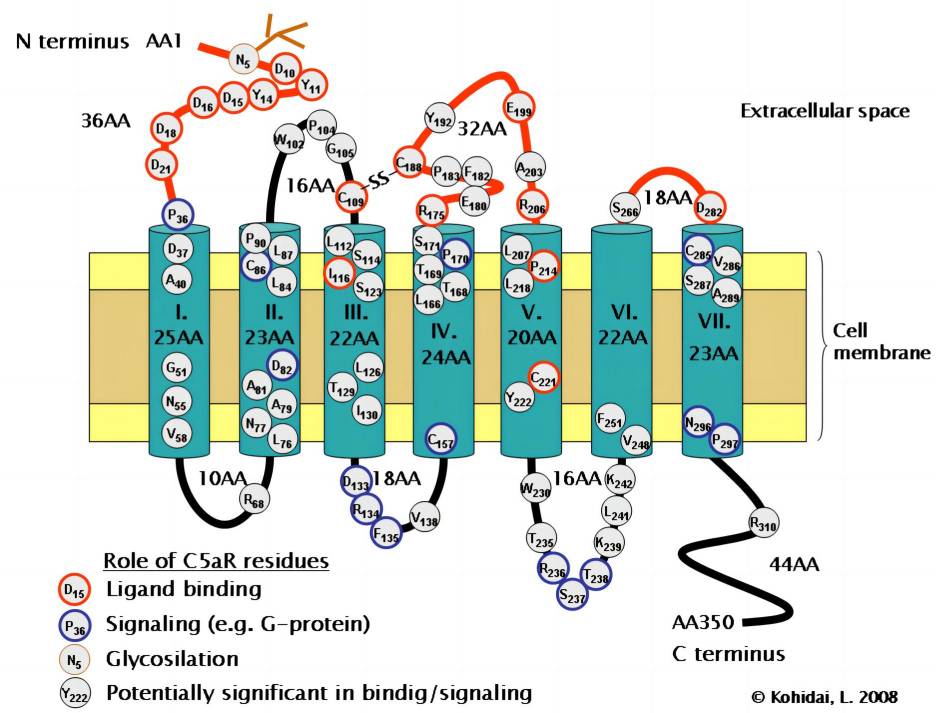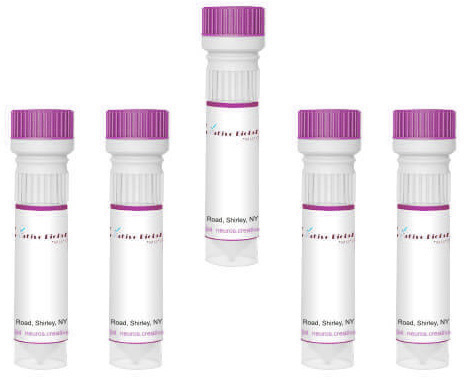Product List Background C5A Functional Service
Background
Complement C5a, a 74 amino acid glycoprotein, is released from the alpha-chain of C5 by C5 convertase enzymes. C5a is made up of four anti-parallel alpha helices connected by peptide loops, stabilized by three critical disulfide linkages. Once cleavage from C5, C5a is soon metabolized by plasma and cell surface carboxypeptidases which remove the C-terminal arginine to form C5adesArg. Compared to C5a, C5adesArg has decreased potency, in line with a lower binding affinity for the classical C5a receptor, CD88. C5a and C5adesArg are cleared rapidly from the body, with ∼50% of both cleared from the circulation within 2–3 min, induced partly by the binding of C5a to CD88 on leukocytes and other cells.
 Fig.1 Diagram illustrating receptor sites for complement component C5a.Distributed under CC BY 3.0, from Wiki, without modification.
Fig.1 Diagram illustrating receptor sites for complement component C5a.Distributed under CC BY 3.0, from Wiki, without modification.
C5a plays an important role in the clearance of pathogens and for host defense via causing several biological effects, such as chemotaxis of inflammatory cells, increased vascular permeability, respiratory burst, cytokine and chemokine release, and phagocytosis. Besides, it has been proven that the functions of C5a are not limited to the primary innate immune response, it is also related to the coagulation system and adaptive immunity. Notably, excessive C5a may lead to an increasing number of pathologies, for example, inflammatory bowel disease, systemic lupus erythematosis, age-related macular degeneration (AMD), sepsis, psoriasis, neurodegenerative disease, cancer, and so on. Nowadays, a range of pharmacological agents to block C5a has been developed, including an analog of compstatin, an inhibitor of C3 cleavage for AMD; and Eculizumab, a monoclonal antibody against C5 for paroxysmal nocturnal hemoglobinuria.
C5A Functional Service
Creative Biolabs provides an extensive range of C5A-related offerings, including anti-C5A antibodies, aptamers, C5A detection ELISA kits, recombinant C5A proteins, C5A immunizing peptides, and C5A inhibitors. These meticulously crafted tools are pivotal for advancing research focused on developing therapeutic approaches for a variety of diseases.
 Fig.2 Visualization of C5A-neuron C5aR interaction following stimulation with C5A alone or combined with PMX53 for 5 minutes by immunostaining.1
Fig.2 Visualization of C5A-neuron C5aR interaction following stimulation with C5A alone or combined with PMX53 for 5 minutes by immunostaining.1
Scientists have pinpointed an essential function for Complement C5A in tissue repair, as it engages with C5aR on target cells. This receptor is expressed in the nervous system, which lacks treatments to restore lost functions upon injury. This study evaluated C5A’s impact on axonal growth post-axotomy in vitro. Employing embryonic Wistar rat hippocampal neurons, C5aR mRNA expression was confirmed via RT-PCR, while immunofluorescence assessed its membrane expression, localization, and phosphorylation. Researchers have demonstrated that Complement C5A markedly increased both the rate and extent of axonal growth within a three dimension-printed microfluidic environment. These findings suggest C5A as a potential therapeutic avenue in central nervous system injury treatment.
Creative Biolabs delivers a comprehensive array of bespoke services related to C5A, including C5A Hemolytic Inhibition Assay, ELISA assay, as well as C5A Deposition assay. These precisely crafted offerings are intended to assist clients in progressing their research and clinical projects.
Reference
-
Cotten, Aurélie, et al. "Complement C5a Implication in Axonal Growth After Injury." Cells 13.20 (2024): 1729. Distributed under Open Access license CC BY 4.0, without modification.


 Datasheet
Datasheet Fig.1 Diagram illustrating receptor sites for complement component C5a.
Fig.1 Diagram illustrating receptor sites for complement component C5a. Fig.2 Visualization of C5A-neuron C5aR interaction following stimulation with C5A alone or combined with PMX53 for 5 minutes by immunostaining.1
Fig.2 Visualization of C5A-neuron C5aR interaction following stimulation with C5A alone or combined with PMX53 for 5 minutes by immunostaining.1
